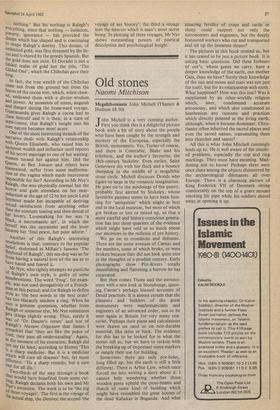Old stones
Naomi Mitchison
Megalithomania John Michell (Thames & Hudson £8.50)
John Michell is a very cunning author. First you think this is a delightful picture book with a bit of story about the people who have been caught by the strength and mystery of the European, especially the British, monuments. Yes, Turner of course, and there is Constable, Blake and his trilithion, and the author's favourite, the 18th-century Stukeley. Even earlier, Saint Genevieve sits with her flock and a bouncy sheepdog in the middle of a megalithic stone circle. Michell discusses Druids who figure so large in the romantic imagination. He goes on to the misdoings of the gentry, probably first alerted by Stukeley, whose favourite pastime seems to have been hun- ting for 'antiquities' which might at best end in the local museum, but most of which got broken or lost or mixed up, so that a more careful and history-conscious genera- tion has lost three quarters of the evidence which might have told us so much about our ancestors in the millenia of pre-history.
We go on to cromlechs and dolmens. There are the stone avenues of Carnac and the menhirs, some of which broke, or were broken because they did not look quite nice in the thoughts of a prudish century. Early photographs show Pitt-Rivers totally demolishing and flattening a barrow he has excavated.
But then comes Thom and the astrono- mers with a new look at Stonehenge, ignor- ing Caesar's perhaps biassed accounts of Druid practices. It is almost certain that the planners and builders of the great monuments were mathematicians and engineers of an advanced order, not to be seen again in Britain for very many cen- turies. Perhaps their plans and calculations were drawn on sand or on non-durable material, like skins or bark. The evidence for this has to be looked for in what the stones tell us, but we have to reckon with the breaking up of important stone markers or simply their use for building.
Sometimes there are only pot-holes, long filled up, but the earth is still a little different. There is Arbor Low, which once forced me into writing a story about it. I cannot help wondering whether those wooden posts upheld the cross-beams and thatch of some kind of building which might have resembled the great houses of the dead Kabakas in Buganda. And what amazing fertility of crops and cattle or sheep could support not only the astronomers and engineers, but the deeply honoured workers who cut and transported and set up the immense stones?
The pictures in this book remind us, but it has ceased to be just a picture book. It is asking basic questions. Did these forbears of our's, whose genes we carry, have a deeper knowledge of the earth, our mother Gaia, than we have? Surely their knowledge of the sun and moon and stars was not just for itself, but for its relationship with earth. What happened? How was this lost? Was it supplanted by an other-worldly religion which, later, condemned accurate astronomy, and which also condemned as heathenism any customs and practices which directly pointed at the living earth, although, when it became dominant, Chris- tianity often inherited the sacred places and even the sacred names, transmuting them into churches and saints?
All this is what John Mitchell cunningly leads up to. He is well aware of the unsolv- ed problems, especially the cup and ring markings. They must have meaning. Mad- dening not to know! Perhaps there were once clues among the objects disinterred by the archaeological dilettantes all over Europe. There is a charming picture of King Frederick VII of Denmark sitting comfortably on the top of a grave mound smoking his pipe while his soldiers shovel away at opening it up.






































 Previous page
Previous page